
How to Develop a Systemic Plan for Scaling Your SEO Agency
They say that the first million is the hardest.
This is especially true for SEO agencies. Starting out and landing a few early clients is (relatively) easy. The SEO market is immense and there are countless resources like this blog to help you out.
But growing from a small team to a seven-figure business requires a whole new set of skills. You need to create processes, build lead-gen systems, and grow your project management chops. As you land bigger and bigger accounts, you’ll have to develop systemic plans to scale your operations.
In this article, I’ll share some of my favorite tips for building a scalable SEO agency.
Build a Scalable Lead Generation System
One of the biggest barriers to growing an SEO agency (or any agency for that matter) is a scalable lead generation system. If your sales team doesn’t have a steady flow of leads to work with, scaling is always going to be a challenge.
Unfortunately, as this HubSpot report shows, most agencies depend on highly unscalable lead sources, such as referrals.
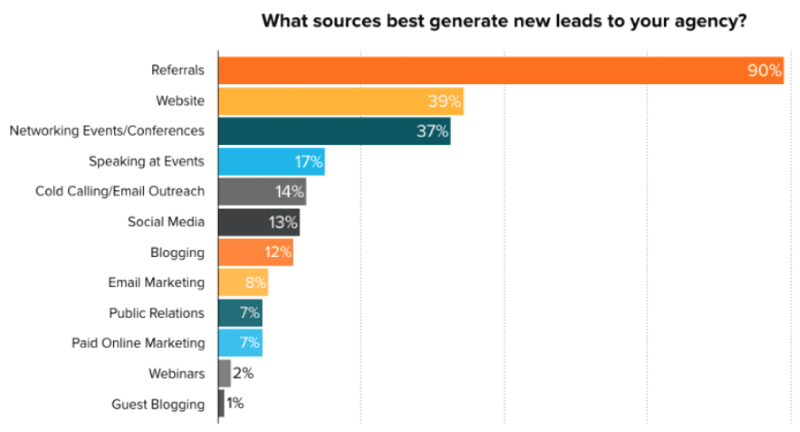
Source: HubSpot. Most agencies depend on referrals for their leads
Although referrals, conference appearances, and cold outreach can be effective (usually in that order), they’re not always scalable. You can’t reasonably rely on them to land you new leads, at least not in the long-run.
The solution to this problem is two-fold:
Adopt more scalable lead-gen tactics such as inbound marketing
Systemize non-scalable tactics (such as outreach or referrals)
Usually, you’ll want to adopt both these approaches. That is, build an inbound lead-gen system that captures leads passively. Combine that with an aggressive outbound approach to sustain non-scalable tactics.
I’ll share a few tips to do this below.
1. Offer free audits to capture leads
Last month, we ran a small survey of agency websites to evaluate the way they sell their services. To our surprise, we found that an exceptionally large number of SEO agencies offered free consultations or audits:
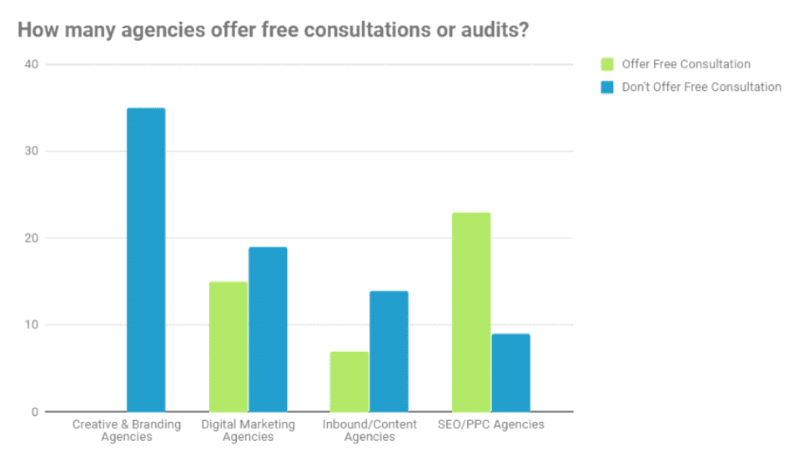
Source: Workamajig. Most SEO agencies offer free consultations or audits
The process is simple enough: agencies offer SEO audits on their websites. Prospective clients enter their key information and get a free audit report.
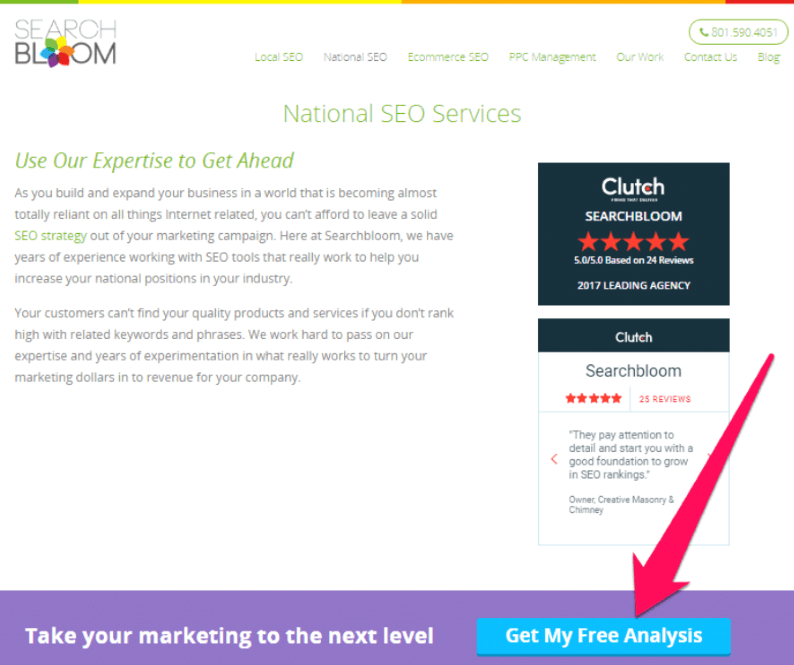
Source: SearchBloom. An example of a free SEO audit
With reasonably targeted traffic and well-optimized CTAs, you can capture leads in a scalable, predictable fashion.
One reason why this tactic works is the relative ease of creating SEO audit reports. An experienced agency can put together a report in under an hour, sometimes even less. For clients, this serves as a proof of work while also giving you crucial lead information.
If you’re going to adopt this approach, keep two things in mind:
Your lead quality will be poor; be prepared to create a qualification process to scrub irrelevant leads.
You’ll mostly capture leads from smaller businesses. If you want to chase larger accounts, this might not be the best solution.
While this tactic doesn’t work for everyone, it can be effective for an agency struggling to capture leads on an ongoing basis.
2. Systemize your referrals
Marketers consistently rank referrals as their top source of quality B2B leads.
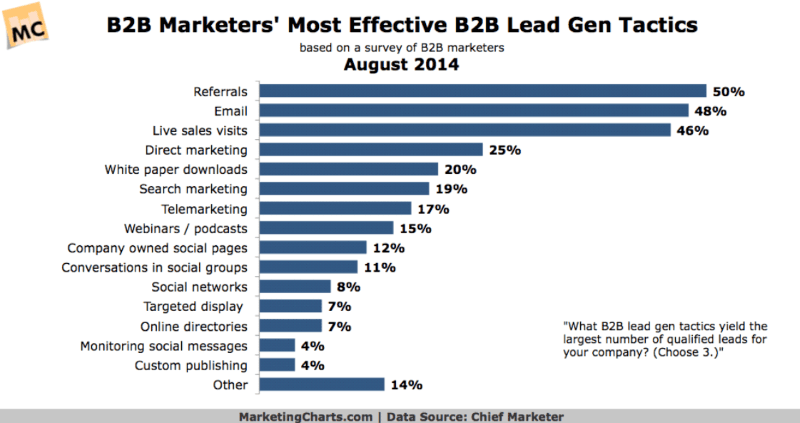
Source: MarketingCharts. Referrals rank alongside email as the best source of new leads for B2Bs
It’s easy to see why: a recommendation from a friend is more persuasive than a testimonial from a stranger.
Although referrals aren’t as scalable as an inbound campaign, you can develop systems to get them in a predictable fashion.
Here’s how:
Start by identifying your happiest clients. These are clients who love your agency enough to recommend it to others.
Use the Net Promoter Score (NPS) to find these clients. At the end of every project, send all your clients a simple NPS survey. Ask them how they would rate your service and the rationale for their score.
Look for clients who score your service as a 9 or 10. These are your ‘promoters’ and are most likely to recommend your agency.

Source: NetPromoterSystem. Net Promoter Score helps you figure out who is most likely to recommend you
Once you’ve identified these clients, send them an automated email to ask for referrals. Since they’ve already shown a willingness to recommend your services, they’ll likely be happy to oblige.
A more targeted approach is to evaluate mutual connections between you and your ‘promoters’ on LinkedIn. If there are any mutual connections that you would like to have as clients, ask these promoters for an introduction.
Another tactic is to use incentivized referrals. Let your clients know that you’ll give them a reward for any new leads or introductions they can give you. As Phillip Reinhardt of PBJ Marketing says, “Economics 101: incentives matter. Spread the word to anyone and everyone you know any and every time of day.”
3. Scale your lead sourcing
Lead sourcing is the process of collecting lead data without the opt-in process that usually accompanies lead generation.
For example, if a lead lands on your website as part of a marketing campaign and fills out a form to download an eBook, it would be lead generation.
However, if you use a lead intelligence tool to gather insight about your site’s visitors, it would be lead sourcing.
Lead sourcing is an underrated tactic for getting new leads into your sales pipeline. When paired with a targeted outreach campaign, it can bring in a steady supply of clients.
Here are a few ways to scale your lead sourcing campaigns:
Use website visitor tracking
Every month, hundreds of people visit your website. Google Analytics can tell you how they interacted with your content, but it can’t tell you whether these visitors were associated with actual businesses.
B2B website visitor tracking tools fill the gap. These tools tie your traffic to specific businesses, effectively “de-anonymizing” your visitors.
Once you know which businesses visited your website and what pages they looked at, you can reach out to them with a cold email. Since they’ve already spent time on your site, they’ve shown at least some interest in your services.
Use lead intelligence tools
Lead intelligence tools can be broadly divided into four categories.
The first, and perhaps most advanced type, are data repositories such as LeadFuze and Datanyze. These tools will help you create lists based on specific keywords, industries, or even people.
These tools are cheap and easy to use but can suffer from outdated data.
An alternative is to use ‘technographic’ tools such as BuiltWith. These tools tell you what technologies a website is using. If you’re targeting clients that use a specific tech stack, this can be a compelling source of leads.
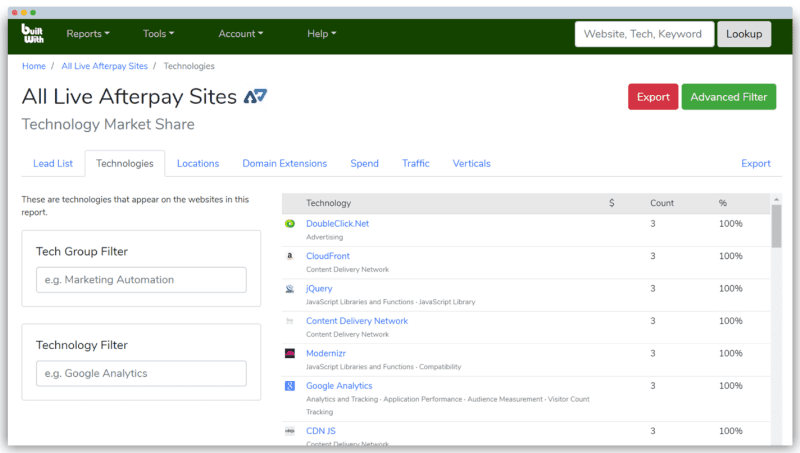
Source: BuiltWith. Tools like BuiltWith help you find websites that use the same tech tools
The third option is to use automated email finder tools such as Voila Norbert or Anymail Finder. If you have an existing collection of names and websites (such as from LinkedIn or Crunchbase), you can use these tools to find their email addresses.
Once you have a set of leads, you can start an automated outreach campaign to push them further down your pipeline and turn them into clients.
The next step in scaling is building a system to serve your clients. Without a standardized service model, you’ll struggle to go beyond a certain size. I’ll show you how to build this system below.
Build a Scalable Service Model
The agency business resists scaling. Unlike a manufacturer or a software developer, you can’t just install additional capacity to serve new customers. The key resource you depend on – people – is subjective. If you hire 10x more designers, you won’t always get 10x more designs.
The solution to this problem is to build systems and develop processes. The more standardized your service model, the easier it will be to scale. If a new client comes in, your people should know exactly what they have to do.
I’ll share a few tips to build a standardized, scalable service model below.
1. Understand the Maturity of Your Existing Systems
Either by luck or by design, some parts of your agency will be more scalable and mature than others. Maybe you already have a powerful lead-gen system. Or maybe your project management methodologies are already standardized.
Your goal should be to:
Assess the maturity of each process in your organization
Bring immature process to parity with more mature ones
Most agency processes can be broken down as follows:
Market focus: Your market focus defines who you sell your services to. A mature market focus would be “ideal customer” driven, i.e. you have a target client that you pursue exclusively. An immature market process would be reactive, i.e. you sell to whoever lands into your pipeline.
Project management: This defines how you manage your projects. If you use ad-hoc solutions, non-standard methodologies, unspecialized tools and personnel, your project management processes would be ‘immature’. However, if you use standardized tools and methodologies (such as Agile or Critical Path Method), your PM processes would be ‘mature’.
Client acquisition: Your client acquisition processes define how you acquire new clients. If you have a scalable system to capture, qualify, nurture, and close leads, your processes would be ‘mature’.
Agency services: These processes define how you serve your clients and deliver solutions. If you’re creating new solutions from scratch for every client, you’d categorize these processes as ‘immature’. However, if your solutions are standardized and repeatable across clients, you can classify them as ‘mature’.
The more your agency leans towards the ‘mature’ side for every process, the easier it will be to scale the business.
2. Map Workflows for Every Client-type
Most agencies can divide their client base into different “types”. You might have a “small local business” client-type, an “early SaaS” client-type, and so on.
The service model for each of these clients would be different. A local business would need citation-building services, while an early SaaS business would need guest posts.
To standardize your service, start by charting the workflow for each client. Map every touch point, interaction, and service from the moment the lead becomes a client to project close. This includes, but isn’t limited to:
Onboarding
Project documents, including project plan, communication plan, charter, etc.
Key communication emails
Website auditing process
Service process
Look to your existing and past clients to figure out these workflows. Get as granular as necessary. Don’t just map the process you used to create the project plan or communication plan; map the emails, messages, and tactics you used internally/externally in the creation process.
A broad, zoomed-out workflow might look like this:
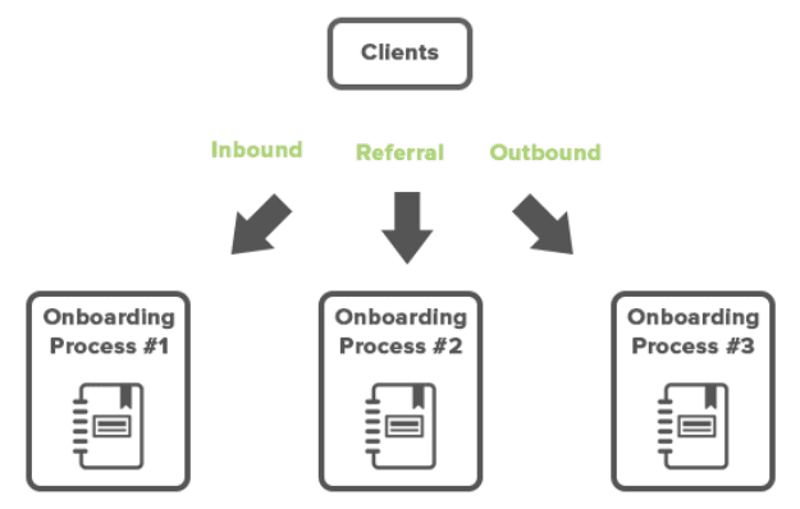
Source: Workamajig. You can create different workflows for different clients depending on their lead source
As you drill into each process, you can standardize its workflow further.
You’ll find that some processes are shared across all clients, some shared across specific client-types, and some completely unique for a single client. If you can standardize the shared processes, you’ll find it much easier to serve clients at scale.
3. Automate and Templatize
In the agency business, you trade time for money. The more time you waste creating SEO reports and writing emails from scratch, the less you’ll have for chasing leads and serving clients.
To scale your business, you need to:
Templatize any document you create more than once
Automate document delivery, notifications, and reminders
Think of all the documents you create in the course of serving a client. Ask yourself: can I turn this into a template? Can I automate its delivery?
For example, as par the onboarding process, you might send clients a series of emails informing them about your service and asking them for key account information. You can scale this process by:
Creating templates for every email
Scheduling their delivery
Creating reminder emails in case of non-receipt of key account information
The more documents you can templatize, the less time you’ll have to waste in creating things from scratch.
Similarly, use automation to remind clients, writers, designers, etc. of upcoming deadlines. If possible, create if-then rules for reminders (“If deadline exceeded by > 5 days, remind via Skype message”).
Automate any routine tasks such as reporting as well. Use tools like AWR to make the reporting process faster. Use this guide if you need help creating a project status report.
Over to You
Scaling an SEO agency – or any business for that matter – is never easy. You have to capture leads on a scalable basis and serve them effectively. The complexities of SEO and the subjective nature of agency work make the scaling process even harder.
Use this guide as a starting point in your scaling efforts. Build a scalable lead-gen system, then standardized processes to serve clients at scale.
Note: The opinions expressed in this article are the views of the author, and not necessarily the views of Caphyon, its staff, or its partners.
Article by
Jeff Sullivan
Jeff Sullivan is a marketing manager at Workamajig, a leading project management tool for agencies. When not brushing up his marketing knowledge, he can be found obsessing over vintage guitars and reading.
stay in the loop




